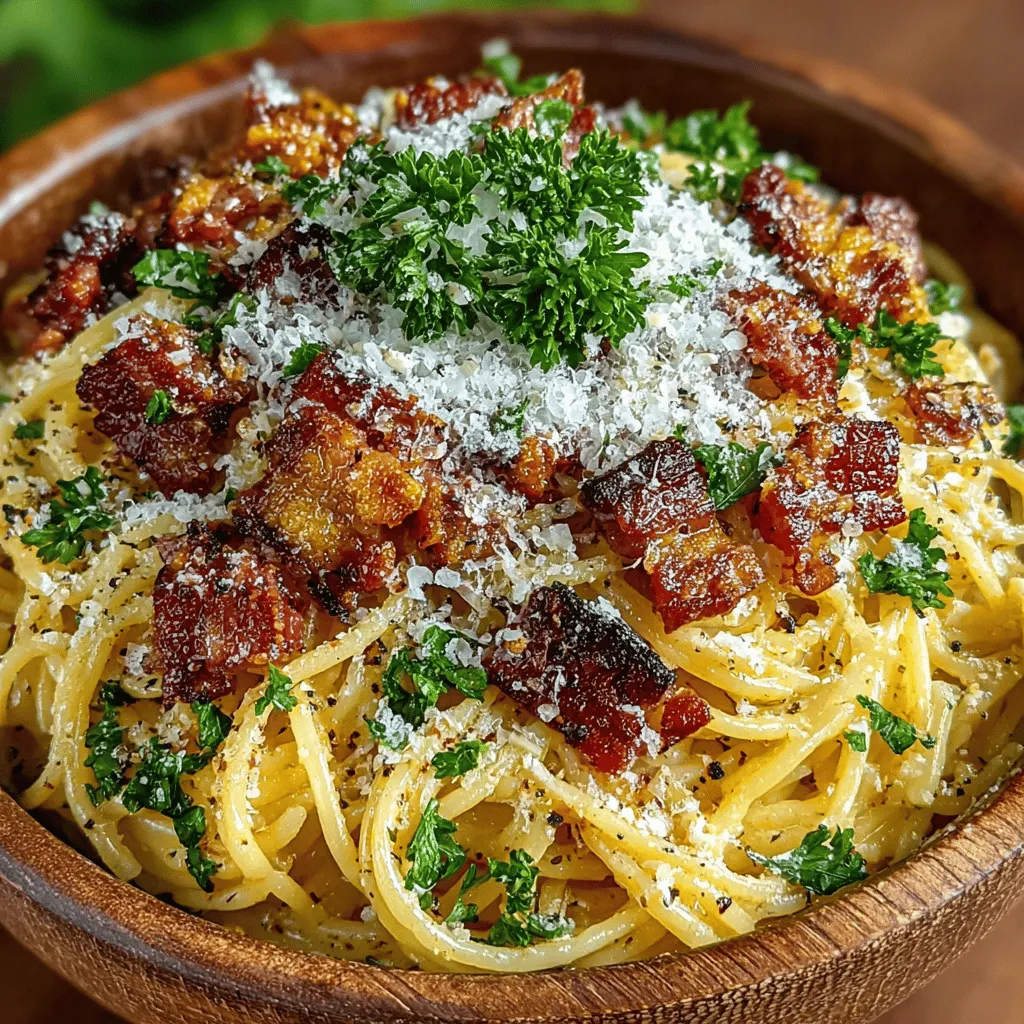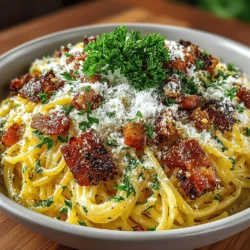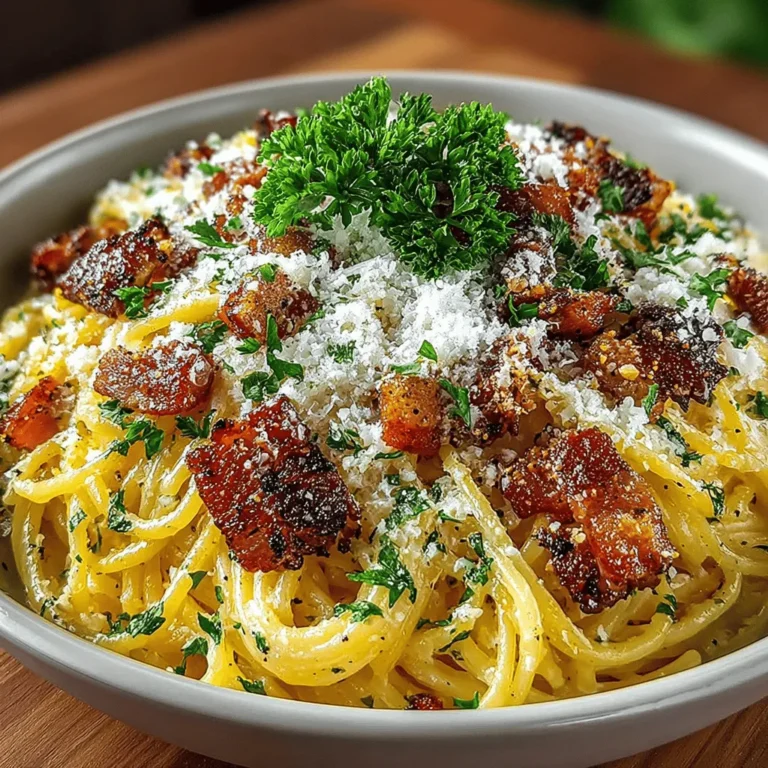Silky Spaghetti Carbonara: A Classic Italian Delight
Spaghetti Carbonara is one of the most beloved dishes in Italian cuisine, renowned for its simplicity and rich, comforting flavors. This traditional Roman dish has captivated the hearts and palates of food lovers around the world, and for good reason. At its core, Carbonara showcases the beauty of minimalism: a handful of high-quality ingredients come together to create a dish that is both indulgent and satisfying.
The allure of Spaghetti Carbonara lies in its creamy texture, which is achieved without the use of heavy creams or sauces. Instead, the dish relies on the magic of egg yolks, cheese, and rendered fat from guanciale or pancetta, creating a silky, luscious sauce that clings to each strand of spaghetti. The dish is not just a meal; it is a testament to the Italian culinary philosophy that emphasizes flavor and quality over complexity.
To make a truly authentic Spaghetti Carbonara, the quality of ingredients is paramount. The traditional recipe calls for guanciale, a type of cured pork cheek that boasts a rich flavor profile, but pancetta can be used as a more accessible substitute. The cheeses, typically a blend of Pecorino Romano and Parmigiano-Reggiano, contribute a distinct sharpness and creaminess that elevate the dish to new heights. Fresh eggs play a crucial role in achieving that signature silky sauce, while garlic and black pepper add depth and richness to the overall flavor.
The origins of Carbonara are somewhat shrouded in mystery, with various theories regarding its creation. Some suggest that it was first made by Italian charcoal workers, or “carbonai,” hence the name. Others believe it emerged in the mid-20th century, gaining popularity after World War II when American soldiers introduced bacon and eggs to the mix. Regardless of its beginnings, Carbonara has become a staple in Italian homes and restaurants, celebrated for its simplicity and flavor.
Understanding the Ingredients
To craft an exceptional Spaghetti Carbonara, it is essential to understand the core ingredients that define this classic dish:
1. Pancetta vs. Guanciale: The choice between pancetta and guanciale can significantly impact the flavor of your Carbonara. Guanciale, made from pork cheek, offers a richer and more authentic taste, as it has a higher fat content and a unique flavor profile. Pancetta, while still delicious, is made from pork belly and is often more readily available. When selecting between the two, consider guanciale for a more traditional approach, but feel free to opt for pancetta if necessary.
2. Cheeses: The combination of Pecorino Romano and Parmigiano-Reggiano is what gives Carbonara its signature creamy texture and sharp flavor. Pecorino Romano, a sheep’s milk cheese, provides a salty bite that enhances the dish, while Parmigiano-Reggiano adds a nutty richness. The balance of these cheeses is key to achieving the desired creaminess in the sauce.
3. Fresh Eggs: The eggs are the backbone of the Carbonara sauce. Using fresh, high-quality eggs is crucial, as they contribute to the silkiness of the sauce once combined with the cheese. The yolks create a rich, velvety sauce that coats the spaghetti beautifully.
4. Garlic and Black Pepper: While not always included in traditional recipes, a hint of garlic can elevate the flavor profile of your Carbonara. Freshly cracked black pepper is essential; it adds a subtle heat and depth that complements the richness of the dish.
Step-by-Step Guide to Making Silky Spaghetti Carbonara
Now that we have a grasp on the ingredients, let’s dive into the step-by-step process of making Silky Spaghetti Carbonara.
Cooking the Spaghetti
The first step in preparing Carbonara is cooking the spaghetti to perfection. The ideal pasta should be al dente, which means it should retain a slight firmness when bitten. To achieve this, follow these instructions:
1. Fill a large pot with water and bring it to a rolling boil. Add a generous amount of salt—this is your only chance to season the pasta itself.
2. Once the water is boiling, add the spaghetti and stir gently to prevent it from sticking together. Cook according to package instructions, usually about 8-10 minutes, but start checking for doneness a minute or two early.
3. Just before draining the pasta, reserve about a cup of the starchy pasta water. This water is a crucial component in achieving the perfect sauce consistency.
Preparing the Sauce Base
While your spaghetti is cooking, it’s time to prepare the sauce base. This involves creating a creamy mixture of eggs and cheese that will form the heart of your Carbonara sauce.
1. In a mixing bowl, add 4 large egg yolks and 1 whole egg. Whisk them together until smooth.
2. Grate a generous amount of Pecorino Romano and Parmigiano-Reggiano cheese, aiming for about 3/4 cup of each. Add the grated cheese to the egg mixture, and whisk until well combined. The consistency should be thick and creamy.
3. Season the mixture with freshly cracked black pepper. The pepper not only enhances the flavor but is also a classic component of Carbonara.
Sautéing the Pancetta
Next, it’s time to sauté the pancetta or guanciale, which will infuse the dish with its rich, savory flavor.
1. In a large skillet or frying pan, heat a drizzle of olive oil over medium heat. Add the diced pancetta or guanciale once the oil is hot.
2. Cook the meat until it becomes crispy and golden, about 5-7 minutes. Be careful not to burn it; you want it to render its fat without becoming overly charred.
3. If you choose to include garlic, add minced garlic to the pan about a minute before the pancetta is finished cooking. This allows the garlic to infuse its flavor without burning.
Combining Pasta and Sauce
The final step is where the magic happens—combining the pasta with the sauce to create that silky, creamy Carbonara.
1. Once the spaghetti is cooked to al dente, drain it and immediately add it to the skillet with the crispy pancetta, tossing to combine. The residual heat from the pasta will help to warm the sauce mixture.
2. Remove the skillet from the heat before adding the egg and cheese mixture. This step is crucial; if the pan is too hot, the eggs can scramble instead of creating a creamy sauce.
3. Slowly pour the egg and cheese mixture over the pasta, quickly tossing to ensure that every strand is coated. If the sauce is too thick, gradually add reserved pasta water a little at a time, until you reach the desired creamy consistency.
The art of mixing is key to achieving that perfect Carbonara texture—each strand of spaghetti should be enveloped in the rich sauce, creating a harmonious balance of flavors.
As you embark on this culinary journey to make Silky Spaghetti Carbonara, remember that the beauty of this dish lies in its simplicity. With the right ingredients and careful attention to technique, you can create a classic Italian delight that brings a taste of Italy to your dining table.

Importance of Residual Heat in Cooking the Eggs
One of the key secrets to achieving a deliciously creamy Spaghetti Carbonara lies in the concept of residual heat. When you combine the hot pasta with the egg mixture, the residual heat from the pasta is what gently cooks the eggs, transforming them into a velvety sauce without scrambling them. This technique requires precise timing and attention to detail, as the eggs must be added at just the right moment.
To maximize the effectiveness of residual heat, ensure that your pasta is cooked al dente, retaining a slight firmness. Immediately after draining, work quickly to combine the hot pasta with the egg and cheese mixture. This allows the heat to envelop the eggs, creating a silky sauce that clings to each strand of spaghetti.
Creating the Creamy Sauce: Achieving the Desired Consistency
To craft the perfect creamy sauce for your Carbonara, you need to focus on the balance of ingredients and technique. The primary components are eggs, Pecorino Romano cheese, and the rendered fat from guanciale or pancetta. As you combine these ingredients, the goal is to achieve a rich, smooth consistency that coats the pasta beautifully.
Start by whisking together the eggs and finely grated cheese until well combined. The mixture should be thick and creamy. If it appears too thick, you can add a tablespoon of reserved pasta water to loosen it slightly. Remember, the sauce should not be soupy; it should cling to the pasta while still maintaining a creamy texture.
How to Adjust Sauce Thickness with Reserved Pasta Water
One of the most useful tricks in pasta cooking is the ability to use reserved pasta water to adjust the consistency of your sauce. Before draining your spaghetti, set aside a cup of the starchy cooking water. This water is infused with flavor from the pasta and contains starch, which helps emulsify the sauce.
If your sauce seems too thick after mixing it with the pasta, gradually add the reserved pasta water a few tablespoons at a time, tossing the spaghetti to combine. The starch in the water will help bind the sauce to the pasta and create a more cohesive dish. Keep an eye on the sauce consistency; it should be creamy and coat the pasta without being watery.
Visual Cues for Determining Sauce Readiness
The visual cues for determining when your Carbonara sauce is ready are essential. When you have mixed the egg and cheese mixture with the hot pasta, look for a glossy sheen that forms as the sauce clings to the spaghetti. The sauce should not be runny; instead, it should have a luxurious texture that coats the pasta evenly.
If you notice that the sauce is starting to look clumpy or curdled, it may be a sign that it has been overcooked. Ideally, the sauce should appear smooth and velvety. If you encounter any lumps, you can use a whisk to gently stir the mixture while the residual heat continues to work its magic.
Serving Suggestions for Spaghetti Carbonara
Once your Spaghetti Carbonara is perfectly prepared, the next step is presenting it in an enticing manner. Here are some serving suggestions to elevate your dish:
Ideal Plating Techniques for Visual Appeal
Plating is an art that significantly enhances the dining experience. For Spaghetti Carbonara, start by twirling a portion of pasta using a fork or tongs. Place the twirled pasta in the center of a warmed plate. This method not only looks impressive but also allows for the sauce to be distributed evenly with each serving.
Best Garnishes to Enhance Flavor and Presentation
To add the finishing touch to your Carbonara, consider garnishing with freshly cracked black pepper and finely chopped parsley. The vibrant green of the parsley provides a beautiful contrast against the creamy sauce, while the black pepper adds a hint of spice that complements the dish beautifully.
Suggestions for Cheese, Black Pepper, and Parsley
While Pecorino Romano is the traditional cheese used in Carbonara, you can experiment with a blend of cheeses to suit your taste. Consider using a combination of Pecorino Romano and Parmesan for a unique flavor profile. For the best black pepper, use freshly cracked peppercorns for a more intense flavor.
Pairing Recommendations: Ideal Wines or Side Dishes that Complement Carbonara
To complete your meal, consider pairing your Spaghetti Carbonara with a crisp white wine such as Pinot Grigio or a light red like Chianti. Both wines enhance the richness of the dish without overwhelming its flavors. For side dishes, a simple arugula salad with lemon vinaigrette can provide a refreshing contrast to the creamy pasta.
Common Mistakes to Avoid in Carbonara Preparation
While preparing Spaghetti Carbonara may seem straightforward, several common mistakes can detract from the final result. Here are some pitfalls to avoid:
Overcooking the Spaghetti: Consequences on Texture
One of the most critical aspects of pasta preparation is timing. Overcooked spaghetti can lead to a mushy texture that doesn’t hold the sauce well. Aim for al dente pasta, which will ensure that the dish has the right bite and can stand up to the creamy sauce.
Cooking Eggs Too Long: Preventing Curdling for a Smooth Sauce
Cooking the eggs too long can result in a scrambled texture rather than a creamy sauce. To prevent this, incorporate the egg mixture with the hot pasta immediately after draining. The residual heat should be sufficient to cook the eggs without scrambling them.
Using Incorrect Cheese or Fats: Impact on Authenticity and Flavor
The authenticity of Carbonara heavily relies on using the right ingredients. Always opt for guanciale or pancetta as your fat source, and stick to Pecorino Romano cheese for the true flavors of traditional Carbonara. Using alternatives like bacon or other cheeses can significantly alter the taste and authenticity of the dish.
Importance of Timing: Ensuring Each Step is Executed with Precision
Carbonara requires precision in timing, as each step builds off the last. From cooking the pasta to mixing the sauce, it’s essential to maintain a smooth flow. Preparing all ingredients before you start cooking can help you work efficiently and avoid any missteps.
The Cultural Significance of Carbonara
Spaghetti Carbonara is more than just a delicious dish; it holds a significant place in Italian culture and history.
Historical Context of Carbonara in Italian Cuisine
The origins of Carbonara are somewhat debated, but it is widely accepted that the dish became popular in the mid-20th century in Rome. Its simplicity and reliance on staple ingredients reflect the culinary traditions of Italian cooking, where quality ingredients shine through in uncomplicated recipes.
Variations Across Different Regions in Italy
While the classic Roman version of Carbonara remains the most famous, different regions of Italy have their interpretations. In some areas, cream is added, while others may include vegetables or different types of cheese. Each variation tells a story of local ingredients and culinary practices.
How Carbonara Has Evolved and Adapted in Global Cuisine
As Spaghetti Carbonara has gained international popularity, chefs around the world have put their spin on the dish. From vegan adaptations to fusion variations, Carbonara continues to evolve while maintaining its core identity as a beloved Italian classic.
The Dish’s Role in Family Gatherings and Celebrations
Carbonara is often associated with family gatherings and celebrations in Italy. Its ability to bring people together around a table reflects the Italian philosophy of sharing meals and creating memories. Whether served on a Sunday dinner or during festive occasions, Carbonara embodies warmth and conviviality.
Conclusion
Making Spaghetti Carbonara is not just about preparing a meal; it’s about embracing Italian culinary tradition and the joy of cooking. The process of creating this dish—from selecting quality ingredients to mastering the technique—offers a rewarding experience that culminates in a delicious reward.
As you explore this recipe, remember that Carbonara is a testament to the beauty of simplicity in cooking. By focusing on quality ingredients and the proper techniques, you can create a dish that not only satisfies the palate but also brings a piece of Italian culture into your home.
So gather your ingredients, embrace the art of cooking, and enjoy the satisfaction that comes with crafting this beloved Italian favorite. Whether for a special occasion or a comforting weeknight dinner, Spaghetti Carbonara is sure to impress and delight anyone who shares in its enjoyment.


